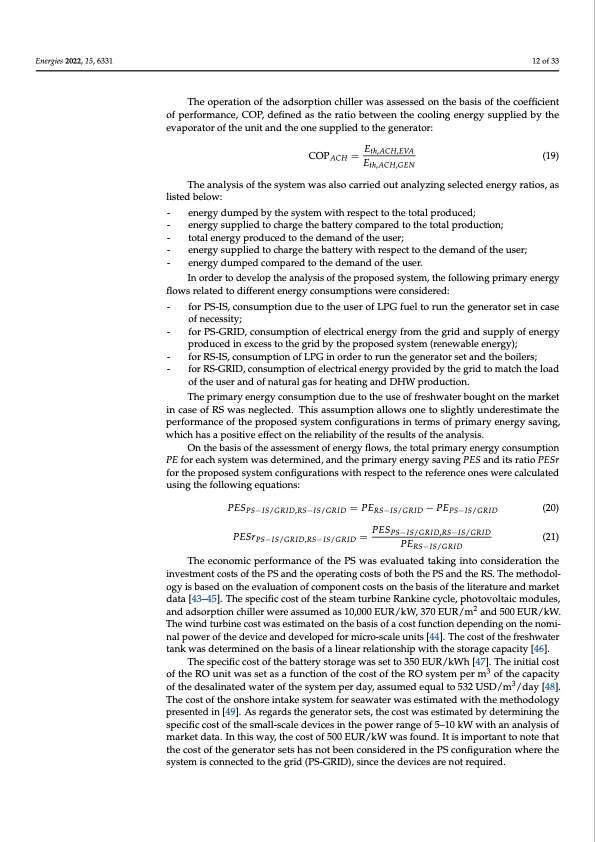
PDF Publication Title:
Text from PDF Page: 012
Energies 2022, 15, 6331 12 of 33 The operation of the adsorption chiller was assessed on the basis of the coefficient of performance, COP, defined as the ratio between the cooling energy supplied by the evaporator of the unit and the one supplied to the generator: COPACH = Eth,ACH,EVA (19) Eth,ACH,GEN The analysis of the system was also carried out analyzing selected energy ratios, as listed below: - energy dumped by the system with respect to the total produced; - energy supplied to charge the battery compared to the total production; - total energy produced to the demand of the user; - energy supplied to charge the battery with respect to the demand of the user; - energy dumped compared to the demand of the user. In order to develop the analysis of the proposed system, the following primary energy flows related to different energy consumptions were considered: - for PS-IS, consumption due to the user of LPG fuel to run the generator set in case of necessity; - for PS-GRID, consumption of electrical energy from the grid and supply of energy produced in excess to the grid by the proposed system (renewable energy); - for RS-IS, consumption of LPG in order to run the generator set and the boilers; - for RS-GRID, consumption of electrical energy provided by the grid to match the load of the user and of natural gas for heating and DHW production. The primary energy consumption due to the use of freshwater bought on the market in case of RS was neglected. This assumption allows one to slightly underestimate the performance of the proposed system configurations in terms of primary energy saving, which has a positive effect on the reliability of the results of the analysis. On the basis of the assessment of energy flows, the total primary energy consumption PE for each system was determined, and the primary energy saving PES and its ratio PESr for the proposed system configurations with respect to the reference ones were calculated using the following equations: PESPS−IS/GRID,RS−IS/GRID = PERS−IS/GRID − PEPS−IS/GRID (20) PESrPS−IS/GRID,RS−IS/GRID = PESPS−IS/GRID,RS−IS/GRID (21) The economic performance of the PS was evaluated taking into consideration the investment costs of the PS and the operating costs of both the PS and the RS. The methodol- ogy is based on the evaluation of component costs on the basis of the literature and market data [43–45]. The specific cost of the steam turbine Rankine cycle, photovoltaic modules, and adsorption chiller were assumed as 10,000 EUR/kW, 370 EUR/m2 and 500 EUR/kW. The wind turbine cost was estimated on the basis of a cost function depending on the nomi- nal power of the device and developed for micro-scale units [44]. The cost of the freshwater tank was determined on the basis of a linear relationship with the storage capacity [46]. The specific cost of the battery storage was set to 350 EUR/kWh [47]. The initial cost of the RO unit was set as a function of the cost of the RO system per m3 of the capacity of the desalinated water of the system per day, assumed equal to 532 USD/m3/day [48]. The cost of the onshore intake system for seawater was estimated with the methodology presented in [49]. As regards the generator sets, the cost was estimated by determining the specific cost of the small-scale devices in the power range of 5–10 kW with an analysis of market data. In this way, the cost of 500 EUR/kW was found. It is important to note that the cost of the generator sets has not been considered in the PS configuration where the system is connected to the grid (PS-GRID), since the devices are not required. PERS−IS/GRIDPDF Image | Hybrid Polygeneration System Based on Biomass Wind and Solar Energy

PDF Search Title:
Hybrid Polygeneration System Based on Biomass Wind and Solar EnergyOriginal File Name Searched:
energies-15-06331-v2.pdfDIY PDF Search: Google It | Yahoo | Bing
Turbine and System Plans CAD CAM: Special for this month, any plans are $10,000 for complete Cad/Cam blueprints. License is for one build. Try before you buy a production license. More Info
Waste Heat Power Technology: Organic Rankine Cycle uses waste heat to make electricity, shaft horsepower and cooling. More Info
All Turbine and System Products: Infinity Turbine ORD systems, turbine generator sets, build plans and more to use your waste heat from 30C to 100C. More Info
CO2 Phase Change Demonstrator: CO2 goes supercritical at 30 C. This is a experimental platform which you can use to demonstrate phase change with low heat. Includes integration area for small CO2 turbine, static generator, and more. This can also be used for a GTL Gas to Liquids experimental platform. More Info
Introducing the Infinity Turbine Products Infinity Turbine develops and builds systems for making power from waste heat. It also is working on innovative strategies for storing, making, and deploying energy. More Info
Need Strategy? Use our Consulting and analyst services Infinity Turbine LLC is pleased to announce its consulting and analyst services. We have worked in the renewable energy industry as a researcher, developing sales and markets, along with may inventions and innovations. More Info
Made in USA with Global Energy Millennial Web Engine These pages were made with the Global Energy Web PDF Engine using Filemaker (Claris) software.
Sand Battery Sand and Paraffin for TES Thermo Energy Storage More Info
| CONTACT TEL: 608-238-6001 Email: greg@infinityturbine.com | RSS | AMP |